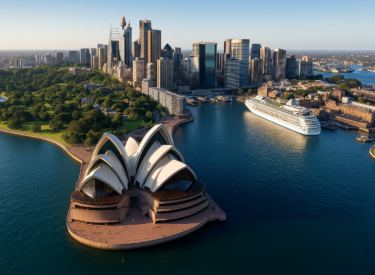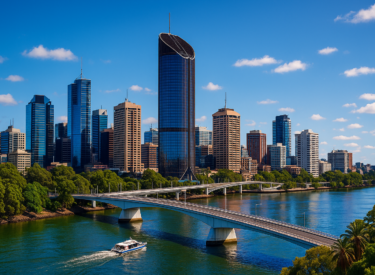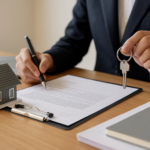
Key takeaways
How we move around cities affects our health, productivity, environment, and wealth.
Australia's car-centric urban design is out of step with emerging global best practice — and it’s costing us.
Our cities are 4–5 times less dense than their European counterparts, forcing reliance on cars.
Everything you need — work, shops, school, healthcare, parks — should be within a 15 (or 20–25) minute radius, ideally without a car.
Bikes are 'time machines' — saving time and improving wellbeing.
Suburbs with good connectivity, walkability, and mixed-use functionality are commanding price premiums.
Investors should look beyond affordability and focus on liveability.
How we move through our cities is about much more than just getting from A to B.
It impacts our health, our productivity, our environment — and yes, even our wealth.
And with Australia’s capital cities continuing to grow, the way we commute is becoming a critical piece of the urban puzzle.
Yet, for most Australians, commuting still means one thing: sitting in traffic.
So here’s a provocative question - what if we stopped designing our cities around cars and started designing them around people?
It’s not a radical thought.
In fact, it’s something our urban planners, demographers and policy experts have been talking about for years.
But it’s not something we’ve fully embraced in Australia… yet.
Recently, demographer Simon Kuestenmacher and I discussed this topic in depth in our Demographics Decoded Podcast — drawing on research, personal experiences, and emerging trends.
And what emerged was a compelling vision of what commuting could be in Australia and how that affects not just our lifestyle, but also property values, generational behaviour, and long-term wellbeing.
Let’s unpack what the future of commuting could look like and what it means for savvy investors, developers, and city dwellers alike.
For weekly insights and strategic advice, subscribe to the Demographics Decoded podcast, where we will continue to explore these trends and their implications in greater detail.
Subscribe now on your favourite Podcast player:
The sprawling problem with Australian cities
Australia’s cities are among the most sprawling in the developed world.
Unlike the compact, dense cities of Europe where population density and smart urban design make walking, cycling, and public transport far more viable, our urban form spreads people over vast areas.
That means long travel times, disconnected communities, and a deep reliance on private vehicles.
Simon noted that Australian cities typically have population densities four to five times lower than similarly sized European cities.
That’s a striking gap, and it carries consequences.
It means, in many suburbs, you simply can’t cycle to work or walk to the shops because the distances are too great.
And while it might be theoretically possible to cycle 15 or 20 kilometres each day, the reality is most people won’t especially those with kids, busy jobs, and ageing knees.
But there is a belt — roughly within 10 to 15 kilometres of the CBD — where walkable, cyclable living is physically and socially feasible.
And that’s exactly where smart urban planners are starting to focus their attention.
Enter: The 15-Minute City
At the heart of this vision is a deceptively simple idea — the 15-minute city.
It’s the notion that everything you need for your daily life — work, school, groceries, parks, doctors, cafes — should be accessible within 15 minutes of your home.
Ideally, without needing to get in a car.
Now, that 15-minute number isn’t gospel.
In Australia, maybe we’re talking about 20 or 25 minutes, depending on the urban fabric.
But the principle stands: a neighbourhood where daily life is local, not spread across a car-dominated metropolis.
This kind of model brings all sorts of benefits:
- Public health: more walking and cycling means fitter, healthier residents.
- Environmental gains: fewer cars, lower emissions.
- Stronger communities: when people walk and cycle, they interact more. They get to know their neighbourhood.
- Lower infrastructure costs: fewer roads, less congestion, lower maintenance.
It’s no wonder urban planners love the concept.
But Simon was quick to point out that while the 15-minute city has been embraced in parts of Europe and Canada, it’s also attracted wild conspiracy theories in some circles suggesting it’s a covert attempt to restrict movement or enforce government control.
That’s nonsense.
The real vision is about freedom — freedom from traffic, long commutes, from urban stress.
It’s about choice — being able to live your life more locally if you want to.

Bicycles as time machines
One of Simon’s more playful metaphors really stuck with me: he called his bicycle a time machine.
Why?
Because it literally buys you time.
For certain trips like a short commute, a quick trip to the shops, or even a doctor’s appointment, cycling is often faster than driving.
You skip the parking hassle, dodge the gridlock, and get some exercise along the way.
But more importantly, you’re combining transport and exercise into one activity.
Let’s say your daily commute is 30 minutes each way by car — that’s an hour of your day.
And then, as the Australian Institute of Health and Welfare recommends, you also need 30 minutes of moderate daily exercise.
So in that car-based routine, you’ve used 90 minutes of your day.
But if you cycle to work and it takes you 45 minutes each way, you’ve covered both goals — commuting and exercise — and you’ve saved time overall.
That’s the magic of multi-functional activity.
That’s why Simon says a bike is a time machine.
It gives you back hours you’d otherwise lose sitting in traffic or at the gym.
And it’s not just efficient.
Cycling, walking, and other forms of active transport are statistically proven to improve mental health.
People feel better when they’re moving, when they’re outdoors, and when they’re not stuck behind a wheel in peak-hour frustration.
In fact, studies show that commuting by car is the single most miserable part of the average person’s day.
That constant sense of delay, of knowing your car could go faster but isn’t, is a recipe for stress.
Cycling, on the other hand, puts you in control.
Your speed, your route, your experience, it’s all up to you.
And control is a powerful driver of well-being.
The limits of car-free dreams
Of course, it’s easy to idealise walkable cities, but the reality is more complicated, especially in Australia.
We’ve simply built too many of our outer suburbs in ways that make local living difficult.
Long roads, cul-de-sacs, single-use zoning, and limited infrastructure, all of it pushes residents into their cars.
Simon called them “gigantic islands of residential zoning.”
That’s a powerful image and an accurate one.
These suburbs might offer affordable house-and-land packages, but they come at a hidden cost: time.
This is where the rubber hits the road for property investors.
Suburbs that offer proximity, connectivity, walkability and mixed-use functionality are increasingly commanding a premium and that trend is only accelerating.
The outer growth corridors may offer short-term affordability, but in the long run, they often lock residents into long commutes, lower liveability, and slower capital growth.

Demographics and the commuting equation
There’s also a fascinating generational lens to all this.
Millennials, who once embraced inner-city living and active transport, are now entering their family-formation years.
And with family-sized homes hard to come by in inner suburbs, they’re being pushed further out to places that are car-dependent by design.
That’s not ideal, because this demographic cohort is the one most willing to embrace cycling, walking, public transport, or working from home.
But we’re forcing them into locations that make those options impractical.
In the long run, this could mean we’ll see more of a bifurcated city:
- Inner and middle-ring suburbs with higher density, better infrastructure, and more walkable communities.
- Outer suburbs remain car-reliant, with longer commutes and fewer lifestyle options.
That divide could have profound impacts on health, wealth, and opportunity.
As an investor, understanding this trend can help you spot which suburbs are likely to outperform, not just based on historical growth or proximity to the CBD, but on future liveability.
Want to know how walkable your suburb is?
There’s a fantastic tool I recommend: WalkScore.com
It gives a numerical rating for how walkable a suburb (or specific address) is — from 0 (totally car-dependent) to 100 (a walker’s paradise).
It considers access to shops, schools, transport, cafes and more.
As Simon pointed out, the Walk Score is more than just a convenience metric, it’s a proxy for wellbeing.
The more walkable a community, the more connected, physically active, and mentally healthy its residents tend to be.
It’s also a powerful signal for investors.
Suburbs with higher walkability scores are generally more resilient to downturns, more appealing to renters, and more likely to benefit from gentrification and infrastructure upgrades.
Final thoughts: time is the ultimate luxury
At the end of the day, commuting is really a conversation about time.
Where do you spend your time?
Who gets to own more of it?
What is it worth to you?
A bicycle isn’t going to fix the housing crisis.
Walkable suburbs won’t eliminate congestion.
And 15-minute cities won’t appear overnight.
But they point us in the right direction — toward cities that are built for people, not just cars.
Toward investments that prioritise liveability.
And toward a future where time isn't something we lose in traffic, it's something we reclaim.
As a property investor, business owner, or resident, it pays to be on the right side of that trend.
If you found this discussion helpful, don't forget to subscribe to our podcast and share it with others who might benefit.
Subscribe now on your favourite Podcast player:














